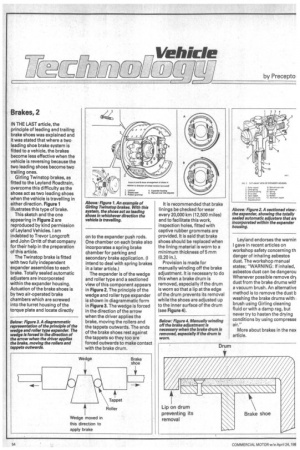Vehicle
Page 48

If you've noticed an error in this article please click here to report it so we can fix it.
l_fiJC 1
IN THE LAST article, the principle of leading and trailing brake shoes was explained and it was stated that where a two leading shoe brake system is fitted to a vehicle, the brakes become less effective when the vehicle is reversing because the two leading shoes become two trailing ones.
Girling Twinstop brakes, as fitted to the Leyland Roadtrain, overcome this difficulty as the shoes act as two leading shoes when the vehicle is travelling in either direction. Figure 1 illustrates this type of brake.
This sketch and the one appearing in Figure 2 are reproduced by kind permission of Leyland Vehicles. I am indebted to Trevor Longcroft and John Orritt of that company for their help in the preparation of this article.
The Twinstop brake is fitted with two fully independent expander assemblies to each brake. Totally sealed automatic adjusters are incorporated within the expander housing. Actuation of the brake shoes is by two air-operated brake chambers which are screwed into the turret housing of the torque plate and locate directly on to the expander push rods. One chamber on each brake also incorporates a spring brake chamber for parking and secondary brake application. (I intend to deal with spring brakes in a later article.) The expander is of the wedge and roller type and a sectioned view of this component appears in Figure 2. The principle of the wedge and roller type expander is shown in diagrammatic form in Figure 3. The wedge is forced in the direction of the arrow when the driver applies the brake, moving the rollers and the tappets outwards. The ends of the brake shoes rest against the tappets so they too are forced outwards to make contact with the brake drum. It is recommended that brake linings be checked for wear every 20,000 km (12,500 miles) and to facilitate this work, inspection holes, fitted with captive rubber grommets are provided. It is said that brake shoes should be replaced when the lining material is worn to a minimum thickness of 5 mm (0.20 in.).
Provision is made for manually winding off the brake adjustment. It is necessary to do this when a brake drum is removed, especially if the drum is worn so that a lip at the edge of the drum prevents its removal while the shoes are adjusted up to the inner surface of the drum (see Figure 4). Leyland endorses the warnin I gave in recent articles on workshop safety concerning th danger of inhaling asbestos dust. The workshop manual states; "WARNING: If inhaled, asbestos dust can be dangerou Whenever possible remove dry dust from the brake drums with a vacuum brush. An alternative method is to remove the dust b washing the brake drums with brush using Girling cleaning fluid or with a damp rag, but never try to hasten the drying conditions by using compresse air."
More about brakes in the nex article.


























































